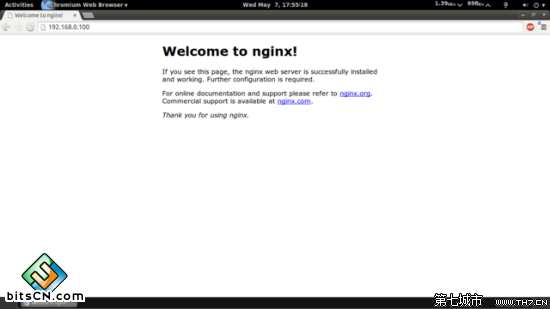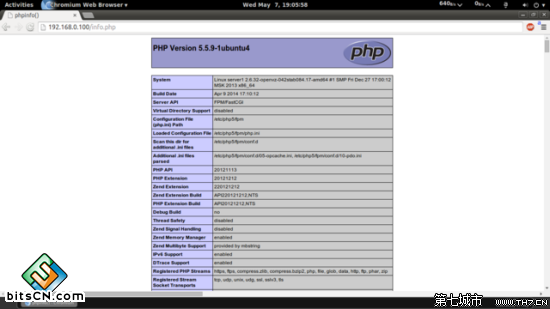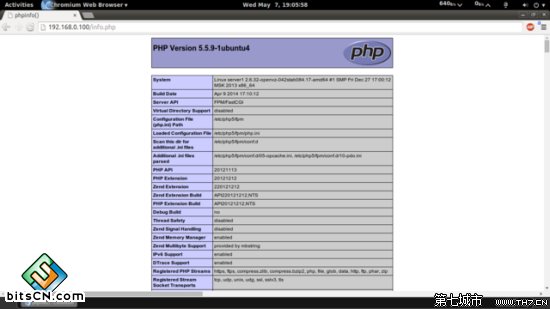InstallingNginxWithPHP5(AndPHP-FPM)AndMySQLSupport(_MySQL
NginxInstalling Nginx With PHP5 (And PHP-FPM) And MySQL Support (LEMP) On Ubuntu 14.04 LTS
Version 1.0
Author: Falko Timme, updated by Srijan Kishore
Last edited 07/May/2014
Nginx(pronounced "engine x") is a free, open-source, high-performance HTTP server. Nginx is known for its stability, rich feature set, simple configuration, and low resource consumption. This tutorial shows how you can install Nginx on an Ubuntu 14.04 server with PHP5 support (throughPHP-FPM) and MySQL support (LEMP =Linux + nginx (pronounced "engine x") +MySQL +PHP) .
I do not issue any guarantee that this will work for you!
1 Preliminary Note
In this tutorial I use the hostnameserver1.example.comwith the IP address192.168.0.100. These settings might differ for you, so you have to replace them where appropriate.
I'm running all the steps in this tutorial with root privileges, so make sure you're logged in as root:
sudo su
2 Installing MySQL 5
In order to install MySQL, we run
apt-get install mysql-server mysql-client
You will be asked to provide a password for the MySQL root user - this password is valid for the userroot@localhostas well asroot@server1.example.com, so we don't have to specify a MySQL root password manually later on:
New password for the MySQL "root" user:<-- yourrootsqlpassword
Repeat password for the MySQL "root" user:<-- yourrootsqlpassword
3 Installing Nginx
Nginx is available as a package for Ubuntu 14.04 which we can install, As Apache2 is installed by default so we will remove it first & then install nginx:
service apache2 stop
update-rc.d -f apache2 remove
apt-get remove apache2
apt-get install nginx
Start nginx afterwards:
service nginx start
Type in your web server's IP address or hostname into a browser (e.g.http://192.168.0.100), and you should see the following page:


The default nginx document root on Ubuntu 14.04 is/usr/share/nginx/html.
4 Installing PHP5
We can make PHP5 work in nginx throughPHP-FPM(PHP-FPM (FastCGI Process Manager) is an alternative PHP FastCGI implementation with some additional features useful for sites of any size, especially busier sites) which we install as follows:
apt-get install php5-fpm
PHP-FPM is a daemon process (with the init scriptphp5-fpm) that runs a FastCGI server on the socket/var/run/php5-fpm.sock.
5 Configuring nginx
The nginx configuration is in/etc/nginx/nginx.confwhich we open now:
vi /etc/nginx/nginx.conf
The configuration is easy to understand (you can learn more about it here:http://wiki.nginx.org/NginxFullExampleand here:http://wiki.nginx.org/NginxFullExample2)
First (this is optional) adjust the number of worker processes and set thekeepalive_timeoutto a reasonable value:
[...]worker_processes4;[...]keepalive_timeout 2;[...] |
The virtual hosts are defined inserver {}containers. The default vhost is defined in the file/etc/nginx/sites-available/default- let's modify it as follows:
vi /etc/nginx/sites-available/default
[...]server { listen 80; listen [::]:80 default_server ipv6only=on; root /usr/share/nginx/html; index index.php index.html index.htm; # Make site accessible from http://localhost/ server_name _; location / { # First attempt to serve request as file, then # as directory, then fall back to displaying a 404. try_files $uri $uri/ /index.html; # Uncomment to enable naxsi on this location # include /etc/nginx/naxsi.rules } location /doc/ { alias /usr/share/doc/; autoindex on; allow 127.0.0.1; allow ::1; deny all; } # Only for nginx-naxsi used with nginx-naxsi-ui : process denied requests #location /RequestDenied { # proxy_pass http://127.0.0.1:8080; #} #error_page 404 /404.html; # redirect server error pages to the static page /50x.html # error_page 500 502 503 504 /50x.html; location = /50x.html { root /usr/share/nginx/html; } # pass the PHP scripts to FastCGI server listening on 127.0.0.1:9000 # location ~ /.php$ { try_files $uri =404; fastcgi_split_path_info ^(.+/.php)(/.+)$; # NOTE: You should have "cgi.fix_pathinfo = 0;" in php.ini # With php5-cgi alone: #fastcgi_pass 127.0.0.1:9000; # With php5-fpm: fastcgi_pass unix:/var/run/php5-fpm.sock; fastcgi_index index.php; include fastcgi_params; } # deny access to .htaccess files, if Apache's document root # concurs with nginx's one # location ~ //.ht { deny all; }}[...] |
Uncomment bothlistenlines to make nginx listen on port 80 IPv4andIPv6.
server_name _;makes this a default catchall vhost (of course, you can as well specify a hostname here likewww.example.com).
I've addedindex.phpto theindexline.root /usr/share/nginx/html;means that the document root is the directory/usr/share/nginx/html.
The important part for PHP is thelocation ~ /.php$ {}stanza. Uncomment it to enable it. Please note that I've added the linetry_files $uri =404;to prevent zero-day exploits (seehttp://wiki.nginx.org/Pitfalls#Passing_Uncontrolled_Requests_to_PHPandhttp://forum.nginx.org/read.php?2,88845,page=3).
Now save the file and reload nginx:
service nginx reload
Next open/etc/php5/fpm/php.ini...
vi /etc/php5/fpm/php.ini
... and setcgi.fix_pathinfo=0:
[...]; cgi.fix_pathinfo provides *real* PATH_INFO/PATH_TRANSLATED support for CGI.PHP's; previous behaviour was to set PATH_TRANSLATED to SCRIPT_FILENAME, and to not grok; what PATH_INFO is.For more information on PATH_INFO, see the cgi specs.Setting; this to 1 will cause PHP CGI to fix its paths to conform to the spec.A setting; of zero causes PHP to behave as before.Default is 1.You should fix your scripts; to use SCRIPT_FILENAME rather than PATH_TRANSLATED.; http://php.net/cgi.fix-pathinfocgi.fix_pathinfo=0[...] |
Reload PHP-FPM:
service php5-fpm reload
Now create the following PHP file in the document root/usr/share/nginx/html:
vi /usr/share/nginx/html/info.php
Now we call that file in a browser (e.g.http://192.168.0.100/info.php):


As you see, PHP5 is working, and it's working through FPM/FastCGI, as shown in theServer APIline. If you scroll further down, you will see all modules that are already enabled in PHP5. MySQL is not listed there which means we don't have MySQL support in PHP5 yet.
6 Getting MySQL Support In PHP5
To get MySQL support in PHP, we can install thephp5-mysqlpackage. It's a good idea to install some other PHP5 modules as well as you might need them for your applications. You can search for available PHP5 modules like this:
apt-cache search php5
Pick the ones you need and install them like this:
apt-get install php5-mysql php5-curl php5-gd php5-intl php-pear php5-imagick php5-imap php5-mcrypt php5-memcache php5-ming php5-ps php5-pspell php5-recode php5-snmp php5-sqlite php5-tidy php5-xmlrpc php5-xsl
APC is a free and open PHP opcode cacher for caching and optimizing PHP intermediate code. It's similar to other PHP opcode cachers, such as eAccelerator and Xcache. It is strongly recommended to have one of these installed to speed up your PHP page.
APC can be installed as follows:
apt-get install php-apc
Now reload PHP-FPM:
service php5-fpm reload
Now reloadhttp://192.168.0.100/info.phpin your browser and scroll down to the modules section again. You should now find lots of new modules there, including the MySQL module:


7 Making PHP-FPM Use A TCP Connection
By default PHP-FPM is listening on the socket/var/run/php5-fpm.sock. It is also possible to make PHP-FPM use a TCP connection. To do this, open/etc/php5/fpm/pool.d/www.conf...
vi /etc/php5/fpm/pool.d/www.conf
... and make thelistenline look as follows:
[...];listen = /var/run/php5-fpm.socklisten = 127.0.0.1:9000[...] |
This will make PHP-FPM listen on port9000on the IP127.0.0.1(localhost). Make sure you use a port that is not in use on your system.
Then reload PHP-FPM:
php5-fpm reload
Next go through your nginx configuration and all your vhosts and change the linefastcgi_pass unix:/var/run/php5-fpm.sock;tofastcgi_pass 127.0.0.1:9000;, e.g. like this:
vi /etc/nginx/sites-available/default
[...]location ~ /.php$ { try_files $uri =404; fastcgi_split_path_info ^(.+/.php)(/.+)$; # NOTE: You should have "cgi.fix_pathinfo = 0;" in php.ini # With php5-cgi alone: fastcgi_pass 127.0.0.1:9000; # With php5-fpm: #fastcgi_pass unix:/var/run/php5-fpm.sock; fastcgi_index index.php; include fastcgi_params;}[...] |
Finally reload nginx:
service nginx reload
8 CGI/Perl Scripts
If you want to serve CGI/Perl scripts with nginx, please read this tutorial:Serving CGI Scripts With Nginx On Debian Squeeze/Ubuntu 11.04
The recommended way is to usefcgiwrap(chapter 4).
9 Links
- nginx:http://nginx.net/
- nginx Wiki:http://wiki.codemongers.com/Main
- PHP:http://www.php.net/
- PHP-FPM:http://php-fpm.org/
- MySQL:http://www.mysql.com/
- Ubuntu:http://www.ubuntu.com/
PHP之友评论